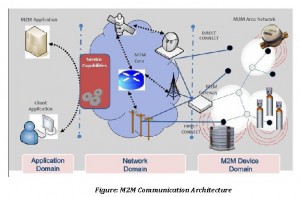By Naveed Kiani
Probably the science fiction movies and novels illustrating set of machines talking to each other are no longer an imaginary world. This is happening now! Thanks to machine to machine (M2M) communication technologies. Right at this time, a stolen vehicle might be reporting its present location, a car might be informing about an emergency situation due to its air bags activation, a photocopier might be alarming for a toner replacement and a smart meter might be informing a household about present energy consumption at home.
Interestingly but not surprisingly, last month a successful test was run on a device that implants sensors in cows to let farmers know when she is ready to give birth; say a cow sending a sms.
Modern machines are equipped with computers that produce information useful to make business processes safer and more efficient. In many situations, the amount of information is not great – at times even a single ‘bit’ of information generated for a change status inside the machine. According to the an independent wireless analyst firm Berg Insight, the number of cellular network connections worldwide used for M2M communication was 47.7 million by 2008, forecasting the number of M2M connections to reach 187 million by 2014. According to Pike Research, in 2008 a mere 4{e1f18614b95d3cd6e4b3128e1cd15d99b042a60a5a19c19b7a8e07e7495efa10} of the planet’s 1.5 billion electric utility meters were smart meters; today that has jumped to 18{e1f18614b95d3cd6e4b3128e1cd15d99b042a60a5a19c19b7a8e07e7495efa10} of electric meters installed. European utilities, which are depending on the technology to help the European Union reach its greenhouse gas emission goals by 2020, expects to have deployed 237 million intelligent meters by that year. Likewise, communications giant Ericsson predicts that there will be over 50 billion intelligent machines fighting for bandwidth by 2020.
The global expansion of IP based networks has made it easier for M2M communication to take place, allowing an array of new business opportunities and connections among the consumers and the producers. M2M is a part of European Telecommunications Standards Institute (ETSI), also defined as Machine Type Communication (MTC) in 3rd Generation Partnership Project (3GPP). M2M communication can be carried out over both fixed and mobile telecommunication networks such as GSM-GPRS, CDMA, EvDO etc. The role of telecommunication network is largely confined to serve as a transport network.
The history of M2M communication touches the year 1995 when Siemens launched a GSM Data module titled ‘M1’ to enable machines to communicate over wireless networks. By 1997, M2M wireless technology became more established and sophisticated as customized modules were developed and launched for the needs of different vertical markets such as automotive and telematics. Today, M2M data modules are becoming extremely sophisticated with a variety of capabilities including flexible land grid array surface mounting, onboard global positioning (GPS) technology, M2M enabled SIM cards and embedded Java technology. In early 2010, market operators fron United States including AT&T, KPN, Rogers, Telcel / America Movil and Jasper Wireless began to work together in the creation of a M2M site, which will serve as a hub for developers in the field of M2M communication electronics. The same year a strategic alliance between Vodafone, Verizon Wireless and nPhase (a joint partnership of Qualcomm and Verizon) was announced to provide global M2M solutions that would enable customers to roll out M2M solutions across Europe and the US.
The present applications of M2M communication envelop many sectors and areas such as:
- Security – Surveillances, Alarm systems, Access control, Car security
- Tracking & Tracing – Fleet management, Order management, Pay as you drive, Asset tracking, Navigation, Traffic information, Road tolling, Traffic optimization.
- Payment – Point of sales, Vending machines, Gaming machines.
- Health – Monitoring vital signs, Supporting the aged or handicapped, Web Access Telemedicine points, Remote diagnostics.
- Remote Maintenance/Control – Sensors, Lighting, Pumps, Valves, Elevator control, Vending machine control, Vehicle diagnostics.
- Metering – Power, Gas, Water, Heating, Grid control, Industrial metering
- Manufacturing – Production chain monitoring and automation
- Facility Management – Home / building / campus automation
The architecture and components of M2M communication consist of various elements including:
M2M Device – Device capable of replying to request for data contained within or capable of transmitting data autonomously.
M2M Gateway – Equipment that uses M2M capabilities to ensure M2M devices inter-working and interconnections to the communication network.
M2M Area Network – A network to provide connectivity between M2M devices and M2M gateways.
M2M Communication Network – A network to provide connectivity between M2M gateways and M2M applications such as xDSL, LTE, WiMAX and WLAN.
M2M Applications – It contains the middleware layer where data goes through various application services and is used by the business processing engines.

M2M communication is useful when you have a significant number of devices to communicate with, whether they are mobile or wired interfaces, and when other methods of communication are impractical or otherwise undesirable. The key concerns related with M2M communication are of addressing and security. M2M communication holds a lot of promises for both telecom operators and vendors. Operators have an opportunity to overlay low-bandwidth M2M applications onto the present user service network. Vendors are expected to produce and sell M2M-capable devices and provide necessary network expansion.










